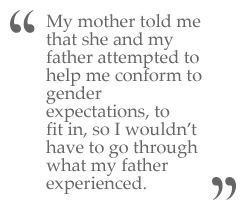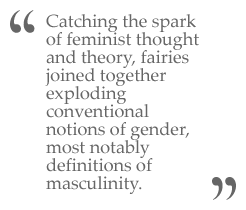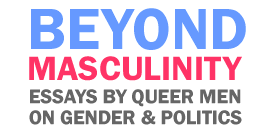|
This kind of bullying and policing of my gender started
the very first day I entered kindergarten. It was 1952
and I was attending public school in Bronxville, NY. As
my mother dropped me off and kissed me good-bye on the
cheek, I felt completely alone and began to cry. My new
teacher walked up to me and said, in a somewhat detached
tone of voice, “Don’t cry. Only sissies and little girls
cry.” Some of the other boys overheard her, and quickly
began mocking me. “The little girl wants his mommy,” one
said. “What a sissy,” said another. Without a word, the
teacher simply walked away. I went into the coatroom and
cried, huddling in a corner by myself, until she found
me.
Years later, in 1970, after I came out as gay to my
parents, I asked my mother why she and my father had
sent me to “the toy doctor,” as they had once called the
psychologist. She looked at me urgently and with deep
affection said:: “You wouldn’t have understood at the
time, but we sent you because we felt you were too
effeminate, and we thought you would grow up to be a
homosexual.” “Your effeminacy,” she continued, “was the
reason why the other children couldn’t accept you and
why they hurt you. We sent you because their taunts hurt
us too, and we couldn’t think of anything else to do.”
 But that wasn’t the whole story; she also confided
another reason for sending me. She told me the story of
how my father suffered the pain of being different when
he was young. He and his two sisters were the only Jews
in their high school in the 1930s in Los Angeles.
Because of the anti-Semitism of the time, the other boys
beat him up nearly every day. While in elementary
school, he hid in a small crawlway beneath one of the
buildings during recess period to avoid attack by his
peers. My mother told me that she and my father
attempted to help me conform to gender expectations, to
fit in, so I wouldn’t have to go through what my father
experienced. But that wasn’t the whole story; she also confided
another reason for sending me. She told me the story of
how my father suffered the pain of being different when
he was young. He and his two sisters were the only Jews
in their high school in the 1930s in Los Angeles.
Because of the anti-Semitism of the time, the other boys
beat him up nearly every day. While in elementary
school, he hid in a small crawlway beneath one of the
buildings during recess period to avoid attack by his
peers. My mother told me that she and my father
attempted to help me conform to gender expectations, to
fit in, so I wouldn’t have to go through what my father
experienced.
My parents sent me to therapy, at least in part, in an
attempt to direct my eventual gender expression and
sexual identity (at the time, they equated my gender
non-conformity to my possible homosexuality). My school
reinforced this on my classmates and me every day. Even
in kindergarten, children were channeled into
gender-specific activities: boys were encouraged to
participate in sports, girls to hone housekeeping skills
such as cooking and cleaning. This less than subtle
encouragement seemed to grow more rigid with every new
year of school.
Despite this, I developed what would become a lifelong
appreciation of music and art. In the fifth grade, I
auditioned for the school chorus and was accepted along
with only a handful of boys and about 50 girls. The
scarcity of boys in the cast was not due to any gendered
imbalance in the quality of boys’ singing voices. The
determining factor was one of social pressure. I and the
other four boys in the chorus were generally disliked by
our peers. In fact, most of the other boys in our class
despised and picked on us, and viciously labeled us “the
chorus girls,” “the fags,” “the sissies,” and “the
fairies.” The girls, on the other hand, who “made it”
into the chorus were well respected and even envied by
the other girls in the school.
The forces that set out to kill Estelle—those societal
battalions bent on destroying all signs of femininity in
every male—nearly succeeded in coercing me into
denouncing her, but through some power more potent than
they, Estelle was victorious in surviving their
relentless attacks. Being mightier and more willful, she
stayed with me through times of torment and times of
“therapeutic” treatment. Even when, due to the
overwhelming negative reactions she received from my
peers, I began to lose trust and to doubt her,, she
never gave up on me.
My friends have often asked me, “What was that energy,
that force empowering Estelle to repel her would-be
executioners?” What kept her strong throughout those
difficult years? I believe that it was, quite simply, a
vision — a vision of social transformation articulated
by feminists during the second wave of the Women’s
emancipation and liberation movement and later by early
gay liberationists during Estelle’s youth.
Looking back through history, for instance, men accused
of same-sex eroticism in the Middle Ages (then called
fairies), for instance, were rounded up, bound, tossed
on the ground like kindling, and unceremoniously set
ablaze. Their burning bodies served to ignite women
accused of witchcraft who were tied just above them.
(This is, of course, where we get the word “faggot” – a
word that originally referred to a bundle of wood used
to start a fire.)
 Many years later, the reverse would be true. Catching
the spark of feminist thought and theory— which
questioned and challenged traditional gender
constructions, the inherent inequalities between the
sexes, and enormous corrosive effects of
heteronormativity—fairies
joined together exploding conventional notions of
gender, most notably definitions of masculinity.
Radically queer groups emerged to disrupt the very
foundations of U.S.-American constructions of gender and
sexuality. During the early 1970s, I was an active
member of Gay Liberation Front in Washington D.C., which
formed the leading edge of a movement rising like a
phoenix from the ashes of the Stonewall Inn in New York
City. Our first meetings were held at Grace Church, the
Washington Free Clinic in Georgetown, and All Souls
Church on 16th Street, until we managed to rent a
brownstone on S Street to establish a Gay Liberation
Front living collective. Meetings provided a space for
gays, lesbians, bisexual women and men, and transgender
people to come together and put into practice what
feminists had taught us—that the “personal is indeed the
political.” ... (continue reading) Many years later, the reverse would be true. Catching
the spark of feminist thought and theory— which
questioned and challenged traditional gender
constructions, the inherent inequalities between the
sexes, and enormous corrosive effects of
heteronormativity—fairies
joined together exploding conventional notions of
gender, most notably definitions of masculinity.
Radically queer groups emerged to disrupt the very
foundations of U.S.-American constructions of gender and
sexuality. During the early 1970s, I was an active
member of Gay Liberation Front in Washington D.C., which
formed the leading edge of a movement rising like a
phoenix from the ashes of the Stonewall Inn in New York
City. Our first meetings were held at Grace Church, the
Washington Free Clinic in Georgetown, and All Souls
Church on 16th Street, until we managed to rent a
brownstone on S Street to establish a Gay Liberation
Front living collective. Meetings provided a space for
gays, lesbians, bisexual women and men, and transgender
people to come together and put into practice what
feminists had taught us—that the “personal is indeed the
political.” ... (continue reading)
|




2 COMMENTS ON THIS ESSAY:
I just loved Estelle and your vision...
Thank you for sharing it with all of us! :)
п»ї
Great page. Good stuff.